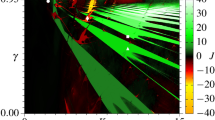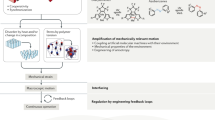Abstract
The possibility to extract work from periodic, undirected forces has intrigued scientists for over a century—in particular, the rectification of undirected motion of particles by ratchet potentials, which are periodic but asymmetric functions. Introduced by Smoluchowski and Feynman1,2 to study the (dis)ability to generate motion from an equilibrium situation, ratchets operate out of equilibrium, where the second law of thermodynamics no longer applies. Although ratchet systems have been both identified in nature3,4 and used in the laboratory for the directed motion of microscopic objects5,6,7,8,9, electronic ratchets10,11,12,13 have been of limited use, as they typically operate at cryogenic temperatures and generate subnanoampere currents and submillivolt voltages10,11,12,13,14. Here, we present organic electronic ratchets that operate up to radio frequencies at room temperature and generate currents and voltages that are orders of magnitude larger. This enables their use as a d.c. power source. We integrated the ratchets into logic circuits, in which they act as the d.c. equivalent of the a.c. transformer, and generate enough power to drive the circuitry. Our findings show that electronic ratchets may be of actual use.
This is a preview of subscription content, access via your institution
Access options
Subscribe to this journal
Receive 12 print issues and online access
$259.00 per year
only $21.58 per issue
Buy this article
- Purchase on Springer Link
- Instant access to full article PDF
Prices may be subject to local taxes which are calculated during checkout




Similar content being viewed by others
Change history
17 December 2010
In the version of this Letter originally published online, the y-axis of Figure 3b should have read 'Output power (µW)' instead of 'Output power (mW)'. This error has now been corrected in the HTML and PDF versions of the text.
References
Smoluchowski, M. V. Experimentell nachweisbare, der Ublichen Thermodynamik widersprechende Molekularphenomene. Phys. Z. 13, 1069–1080 (1912).
Feynman, R. P., Sands, M. L. & Leighton, R. B. The Feynman Lectures on Physics (Addison-Wesley, 1989).
Prakash, M., Quere, D. & Bush, J. W. M. Surface tension transport of prey by feeding shorebirds: The capillary ratchet. Science 320, 931–934 (2008).
Svoboda, K., Schmidt, C. F., Schnapp, B. J. & Block, S. M. Direct observation of kinesin stepping by optical trapping interferometry. Nature 365, 721–727 (1993).
van Oudenaarden, A. & Boxer, S. G. Brownian ratchets: Molecular separations in lipid bilayers supported on patterned arrays. Science 285, 1046–1048 (1999).
Linke, H. et al. Self-propelled Leidenfrost droplets. Phys. Rev. Lett. 96, 154502 (2006).
Mahmud, G. et al. Directing cell motions on micropatterned ratchets. Nature Phys. 5, 606–612 (2009).
Rousselet, J., Salome, L., Ajdari, A. & Prost, J. Directional motion of Brownian particles induced by a periodic asymmetric potential. Nature 370, 446–448 (1994).
Bader, J. S. et al. DNA transport by a micromachined Brownian ratchet device. Proc. Natl Acad. Sci. USA 96, 13165–13169 (1999).
Linke, H. et al. Experimental tunnelling ratchets. Science 286, 2314–2317 (1999).
Linke, H. et al. Asymmetric nonlinear conductance of quantum dots with broken inversion symmetry. Phys. Rev. B 61, 15914–15926 (2000).
Khrapai, V. S., Ludwig, S., Kotthaus, J. P., Tranitz, H. P. & Wegscheider, W. Double-dot quantum ratchet driven by an independently biased quantum point contact. Phys. Rev. Lett. 97, 176803 (2006).
Majer, J. B., Peguiron, J., Grifoni, M., Tusveld, M. & Mooij, J. E. Quantum ratchet effect for vortices. Phys. Rev. Lett. 90, 056802 (2003).
Song, A. M. et al. Room-temperature and 50 GHz operation of a functional nanomaterial. Appl. Phys. Lett. 79, 1357–1359 (2001).
For a review see: Hanggi, P. & Marchesoni, F. Artificial Brownian motors: Controlling transport on the nanoscale. Rev. Mod. Phys. 81, 387–442 (2009).
For a review see: Reimann, P. Brownian motors: Noisy transport far from equilibrium. Phys. Rep.-Rev. Sec. Phys. Lett. 361, 57–265 (2002).
Linke, H. Ratchets and Brownian motors: Basics, experiments and applications. Appl. Phys. A 75, 167–167 (2002).
Eshuis, P., van der Weele, K., Lohse, D. & van der Meer, D. Experimental realization of a rotational ratchet in a granular gas. Phys. Rev. Lett. 104, 248001 (2010).
Loutherback, K., Puchalla, J., Austin, R. H. & Sturm, J. C. Deterministic microfluidic ratchet. Phys. Rev. Lett. 102, 045301 (2009).
Sassine, S. et al. Experimental investigation of the ratchet effect in a two-dimensional electron system with broken spatial inversion symmetry. Phys. Rev. B 78, 045431 (2008).
Silva, C. C. D., de Vondel, J. V., Morelle, M. & Moshchalkov, V. V. Controlled multiple reversals of a ratchet effect. Nature 440, 651–654 (2006).
Cantatore, E. & Meijer, E. J. ESSCIRC. Proc. 29th Eur. Solid State Ciruits Conf. 29–36 (2003).
Knipp, D., Kumar, P., Volkel, A. R. & Street, R. A. Influence of organic gate dielectrics on the performance of pentacene thin film transistors. Synth. Met. 155, 485–489 (2005).
Wu, Y. L., Li, Y. N. & Ong, B. S. Printed silver ohmic contacts for high-mobility organic thin-film transistors. J. Am. Chem. Soc. 128, 4202–4203 (2006).
Acknowledgements
We thank Dago M. de Leeuw and Simon G. J. Mathijssen for comments and discussions. This research is supported by the Dutch Technology Foundation STW, which is the applied science division of NWO, and the Technology Programme of the Ministry of Economic Affairs (VIDI grant 07575).
Author information
Authors and Affiliations
Contributions
E.M.R., W.C.G. and M.K. designed the experiments. E.M.R. carried out the experiments. E.M.R., W.C.G., R.A.J.J. and M.K. analysed the data. E.M.R. and M.K. made the simulation model and conducted the simulations. E.M.R., W.C.G., R.A.J.J. and M.K. wrote the manuscript. E.M.R., W.C.G., B.S., E.J.G. and T.d.V. fabricated the samples. R.A.J.J. and M.K. supervised the project.
Corresponding author
Ethics declarations
Competing interests
The authors declare no competing financial interests.
Supplementary information
Supplementary Information
Supplementary Information (PDF 2547 kb)
Rights and permissions
About this article
Cite this article
Roeling, E., Germs, W., Smalbrugge, B. et al. Organic electronic ratchets doing work. Nature Mater 10, 51–55 (2011). https://doi.org/10.1038/nmat2922
Received:
Accepted:
Published:
Issue Date:
DOI: https://doi.org/10.1038/nmat2922
This article is cited by
-
Collective transient ratchet transport induced by many elastically interacting particles
Scientific Reports (2021)
-
Normal and inverted regimes of charge transfer controlled by density of states at polymer electrodes
Nature Communications (2017)
-
Quantum ratchet in two-dimensional semiconductors with Rashba spin-orbit interaction
Scientific Reports (2015)
-
Superconducting/magnetic Three-state Nanodevice for Memory and Reading Applications
Scientific Reports (2015)
-
Magnetic quantum ratchet effect in graphene
Nature Nanotechnology (2013)



